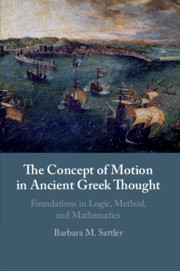Book contents
- The Concept of Motion in Ancient Greek Thought
- The Concept of Motion in Ancient Greek Thought
- Copyright page
- Contents
- Acknowledgements
- Introduction
- 1 Conceptual Foundations
- 2 Parmenides’ Account of the Object of Philosophy
- 3 Zeno’s Paradoxes of Motion and Plurality
- 4 The Atomistic Foundation for an Account of Motion
- 5 The Possibility of Natural Philosophy According to Plato I: The Logical Basis
- 6 The Possibility of Natural Philosophy According to Plato II: Mathematical Advances and Ultimate Problems
- 7 Aristotle’s Notion of Continuity: The Structure Underlying Motion
- 8 Time and Space: The Implicit Measure of Motion in Aristotle’s Physics
- 9 Time as the Simple Measure of Motion
- Bibliography
- Index Locorum
- General Index
5 - The Possibility of Natural Philosophy According to Plato I: The Logical Basis
Published online by Cambridge University Press: 28 September 2020
- The Concept of Motion in Ancient Greek Thought
- The Concept of Motion in Ancient Greek Thought
- Copyright page
- Contents
- Acknowledgements
- Introduction
- 1 Conceptual Foundations
- 2 Parmenides’ Account of the Object of Philosophy
- 3 Zeno’s Paradoxes of Motion and Plurality
- 4 The Atomistic Foundation for an Account of Motion
- 5 The Possibility of Natural Philosophy According to Plato I: The Logical Basis
- 6 The Possibility of Natural Philosophy According to Plato II: Mathematical Advances and Ultimate Problems
- 7 Aristotle’s Notion of Continuity: The Structure Underlying Motion
- 8 Time and Space: The Implicit Measure of Motion in Aristotle’s Physics
- 9 Time as the Simple Measure of Motion
- Bibliography
- Index Locorum
- General Index
Summary
Chapter 5 examines the development of the logical basis required for natural philosophy in Plato. In particular it shows how Plato in the Sophist develops further understanding not only of negation and the connection operator, but also, in connection with this, the principle of non-contradiction. These developments allow for connecting Being and non-Being, which is necessary for making sense of motion without falling into inconsistencies. The chapter then examines Plato’s employment of the principle of sufficient reason and the criterion of rational admissibility in the Timaeus. He develops the principle of sufficient reason further by distinguishing for the first time between necessary and rational reasons. And rational admissibility is taken up by Plato in the way used by the atomists: that is, the basic ontological constituents not only have to be testable by our own reason, but they also have to explain the phenomena. These requirements together emerge as Plato’s standards for natural philosophy and cosmology by being the positive criteria an eikôs mythos has to fulfil.
- Type
- Chapter
- Information
- The Concept of Motion in Ancient Greek ThoughtFoundations in Logic, Method, and Mathematics, pp. 202 - 244Publisher: Cambridge University PressPrint publication year: 2020



